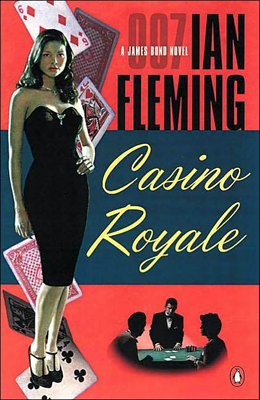 BUY IT AT AMAZON: CLICK HERE!
BUY IT AT AMAZON: CLICK HERE!
PUBLISHER: Penguin
MSRP: $13.00
PAGES: 192
There’s great fun to be had in reviewing an icon of literature. Especially if one, like me, has somehow managed to never read that piece of literature before. I don’t know how I’ve done it, but despite a childhood of reading and a series of creative courses by a professor who drank pulp fiction like his favorite beer, I hadn’t read a James Bond novel before Casino Royale appeared in my mailbox. Now I can dissect with impunity! Why? Because, if I say something wrong in my criticism, well, shucks, I just don’t know any better.
I’ve seen all the movies, but, as you’ll soon read, there’s not a whole lot in common between Ian Fleming’s afternoon novels and the cinematic tradition of James Bond.
Released to coincide with the upcoming film re-adaptation, Casino Royale is a quick, exciting, introduction to the character of James Bond. It was Fleming’s first published Bond novel and, as introductions go, it covers all its bases. Awkwardly-placed flashbacks to flesh out character history? Present! Expository prose to describe Bond as a character rather than showing those traits? Here! Intimations of homoerotic behavior? Accounted for!
I tease because I love. The plot of Casino Royale follows James Bond as he is sent on an assignment to — get this — defeat a bad guy in a game of baccarat. No cheating, no special tricks up his sleeve. Just a guy and his much-lauded skill at the game. Let me rephrase, just for fun: James Bond gets sent on a mission to play a game of chance. It’s ludicrous. I love it.
It seems that Bond’s opponent is an anonymous mobster named Le Chiffre with ties to a Russian murder syndicate. Le Chiffre has been on the outs with his mates, after a string of business failures. Now, at the grand Casino Royale, he plans to make back all the money he owes his bosses, thus assuring their continued dominance and his continued breathing habit. Enter one Bond, James, and a mad little plot to legally obtain Le Chiffre’s money, and mosey on back to
You might not think that Bond could manage a good mosey, but it’s true. At least in Casino Royale, Bond is not the character that he has become, through the many iterations of the franchise. Of course, he’s something of a serial character, like the Dread Pirate Roberst, but even considering that Fleming’s Bond as he first appears on the page is a far cry from our familiar secret agent. He is consumed by doubts, occasionally awkward in action, at least once slow to think, and more emotionally bare than a spy who makes up his own alcoholic beverages should be. He is not the cold, calculating Bond that we have come to know, but instead harbors regrets, and even holds on to a bit of remorse for the victims that earned him his double-O status.
If you snap this up and give it a read, you may notice that the material from the new Casino Royale adaptation seems to have little in the way of shared genetic material with the novel. In fact, I’d hazard a guess that the milkman is the movie’s father. The differences in the character of Bond have something to do with the discrepancies, but mostly it’s the places the plot goes that diverge.
For example: roughly one half of the novel is devoted to back story leading up to the climactic baccarat game. For those of you keeping score, that puts the traditional third act emotional peak smack dab in the middle of the story. After that comes a little bit of testicle torture. Actually, a whole lot of testicle torture. The penis may have gotten involved. It’s too much of a mess down there to really tell.
Beyond that, Bond takes a solid third of the remainder to convalesce, and then to spend some time with his femme fatale. Fleming took a fun concept, made with the lightning-quick adventure for a hundred pages, and then kind of let things go. He made it over the peak, and figured he could just coast to the bottom, I guess. It’s a violent shift in tone that makes the two stories seem almost completely unrelated. Here, in part one, you get Bond the super-spy; there, in part two, you get Bond the tied-to-a-chair-and-emasculated.
There is a good deal of interest in the second half, mostly from a modern critical standpoint, because it is a fascinating dissection of the character and concept of James Bond. Here, he possesses some emotional depth, though it’s that depth is borrowed and stolen from writers who understand characterization far more than did Fleming. The point is that he is not at all the Bond who currently hangs about the lower tiers of the cinematic pantheon.
Casino Royale is more about Bond the character than Bond the spy. It’s really more like having two pulp novels squished together: the seedy adventure and the gothic, tragic romance. They’re both great fun, as curiosities and touchstones of popular fiction.
(Any chance of starting a petition to get the producers of the new Casino Royale to “remain true to the vision of Fleming” and introduce a little whack-whack in the ol’ sack? That’s the James Bond we want to know.)
Judging the Book by its Cover: Awesome, in an undiluted form. I love that the designers brought back and enhanced the bold colors, the collage of scenes, the fronted femme. I’m particularly pleased that they it doesn’t have the movie poster slapped on there. Let’s hear it for retro suave.
7.1 out of 10